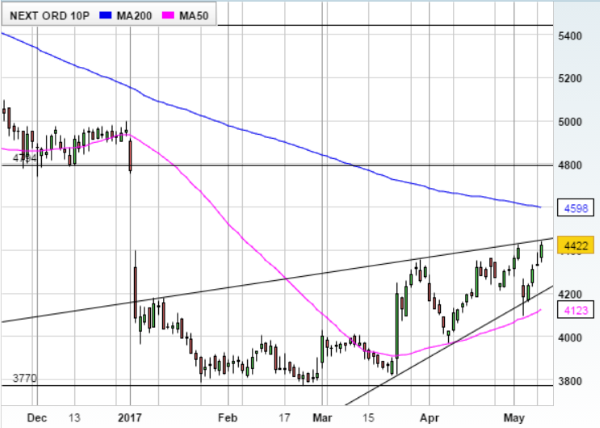Why buyers are piling into Next shares
10th May 2017 12:08
What to make of ? A week ago shares in the struggling fashion retailer fell 7% to below £41 for the first time since early April, as it confirmed sales fell in the first quarter. But now, one former doubter has crunched the numbers and had a rethink. They've called it right before, so an upgrade like this is worth listening to.
Two major profits warnings have knocked the stuffing out of Next, halving the share price since that December 2015 high at over £81. Fears about rising inflation, higher costs, weak consumer confidence and competition from online rivals have dampened enthusiasm among investors.
That was until full-year results late March when they rediscovered their buying boots, despite a first fall in annual sales since the recession. Clearly, a prospective dividend yield of around 8% - assuming special dividends get paid - was impossible to resist.
Next shares have been erratic, but the trend has been positive and Next now trades at a four-month high. It will be more if Investec Securities analysts Alistair Davies and Kate Calvert are correct.
In a 32-page note to clients, the pair argue that Next "appears better-placed vs mid-market peers to weather the storm facing the sector".
"Detailed analysis shows Next has, unlike its peers, been actively managing its portfolio over the last 10 years. In our view this is over-looked by investors pre-occupied by short-term trading."

Square footage at the retail operation is 53% higher than a decade ago, although the number of stores is up just 12%. New space is highly profitable, there are fewer onerous lease commitments, and current retail margins of around 12% - down from near-17% in 2016 - "appear sustainable", even if retail sales keep falling.
True, Investec expects a plunge in underlying pre-tax profit this year from £790 million to just £701 million, and for little or no improvement until at least 2021. But there are self-help opportunities - markdown and clearance activity, and overcoming recent lack of availability on key lines - and any return to share buybacks would allow earnings per share (EPS) growth.
"In our view, valuation doesn't reflect Next's qualities as a well-invested business with strong and sustainable cash flows," says Investec.
Currently, Next trades on 11 times calendar-year EPS estimates, an 18% discount to the sector on 13.4 times and 12% discount to its own 10-year average of 12.5. For the past decade Next has traded in line with peers.
"In fairness, this does partly reflect investors' concern over whether profits could unravel, rather than merely tracking sideways as we expect," says the broker. "Fundamentally however, we think Next's valuation is attractive and not reflective of its qualities."
That's why the rating is upgraded from 'hold' to 'buy' and the price target by 22% from £39 to £47.50. That implies 7% upside from here, even after a mini-rally Wednesday, and still leaves the shares at a 10% discount to the sector.
But Investec believes there's "upside risk" to this target from any further re-rating should confidence that profits are at least stabilising post full-year 2018 return.
Investec's argument is convincing, and they've been right in the past. The broker cut its rating from 'hold' to 'sell' following a shock profits warning alongside full-year results in March 2016.
The price subsequently fell from around £60 to below £36 briefly following the EU referendum.
That price target looks achievable, too, certainly from a charting perspective.
Around the £48 level is a key technical level, representing the 23% Fibonacci retracement of the decline from December 2015 high to 2017 lows. It's been significant in the past, both in 2013 and prior to this January's warning.
However, there'll need to be a serious catalyst to break the shares out of their current wedge pattern. Do that and the next move could be dramatic. Let's hope it's in the right direction.
This article is for information and discussion purposes only and does not form a recommendation to invest or otherwise. The value of an investment may fall. The investments referred to in this article may not be suitable for all investors, and if in doubt, an investor should seek advice from a qualified investment adviser.
Editor's Picks